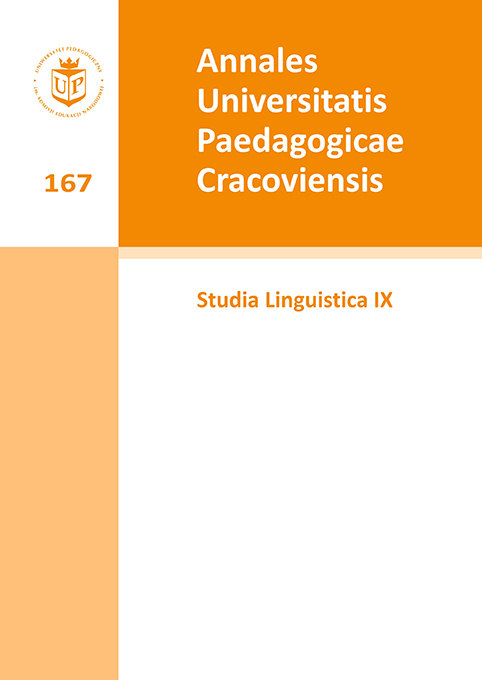Nazwy drogi we współczesnej polszczyźnie. Analiza leksykalno-semantyczna
Main Article Content
Abstract
The author explicates the semantics of the concept of road in systemic data (etymology, dictionary definitions, semantic derivatives, compounds, collocations, and synonyms) on the basis of contemporary lexicographic data. She divides the analysis into two parts. In the first part, she presents successive constituents of the semantics of the road (156 altogether), in the second she reconstructs the cognitive structure of the linguistic image of the road as an element of space, the structure being presented in the following facets: hypernyms, functions, origin of the road, location, network, hierarchy of roads, parts, appearance, features, the road as the localizer of people (and plants and animals, beings from the sphere of the sacred as well as objects), actions, and emotions.
Downloads
Article Details
Author, submitting a text to the editorial board of the journal “Annales Universitatis Paedagogicae Cracoviensis. Studia Linguistica", certifies that the content of the article has not been published so far and that the work does not violate in any way the copyright or related rights of other person, as well as other rights of third parties, and that no one's rights to the work (or any part thereof) have been missed. After signing the contract, the property rights to the published materials are transferred to the Scientific Publisher of the University of the National Education Commission, Krakow.
“Annales Universitatis Paedagogicae Cracoviensis. Studia Linguistica” is an open access journal, and all its content is made available free of charge to users and institutions under the Creative Commons CC-BY-NC-ND 4.0 license (attribution, non-commercial use, no derivative works). Under this license, the authors agree that their work may be lawfully reused for any purpose, except for commercial purposes, without the prior consent of the author or publisher. Everyone can read, download, copy, print, distribute and process these works, provided that the author's marking and the original publication place are correct. Published texts may not be used to create derivative works (e.g. to translate and publish in another language without the consent of the publisher). This is in line with the BOAI (Budapest Open Access Initiative) definition. "Studia Linguistica" does not charge for submitting or processing articles.
References
Adamowski J., 1999, Kategoria przestrzeni w folklorze. Studium etnolingwistyczne, Lublin.
Google Scholar
Adamowski J., 2010, Na drodze życia, czyli o semantyce drogi w przysłowiach polskich, [w:] W świecie nazw. Księga jubileuszowa dedykowana Profesorowi Czesławowi Kosylowi, red. H. Pelcowa, Lublin, s. 31–35.
Google Scholar
Bartmiński J., 1973, O języku folkloru, Wrocław.
Google Scholar
Bartmiński J., 2006, Językowe podstawy obrazu świata, Lublin.
Google Scholar
Chudzik A., 2011, Droga jako metafora językowa, [w:] Droga w języku i kulturze. Analizy antropologiczne, red. J. Adamowski, K. Smyk, Lublin, s. 27–36.
Google Scholar
Cleary Th., 2000, Istota Tao. Wprowadzenie w podstawy taoizmu na podstawie oryginału Tao Te Ching oraz nauk wewnętrznych Chuang-tzu, tłum. S. Musielak, R. Bąk, K. Fordoński, Poznań.
Google Scholar
Czeremski M., Zawiła M., 2012, Podróż jako metaforyczny model religii potocznej. Teoria metafory pojęciowej w badaniach religioznawczych, „Przegląd Religioznawczy”, nr 3 (245), s. 87–105.
Google Scholar
Kazojć J., 2011, Słownik frekwencyjny języka polskiego V.05.2011, [w:] Słowniki, www. slowniki.org.pl/lista-frekwencyjna.pdf (dostęp: 21.10.2013).
Google Scholar
Kowalski P., 2007, Kultura magiczna. Omen, przesąd, znaczenie, Warszawa.
Google Scholar
Krzeszowski T., 1999, Aksjologiczne aspekty semantyki językowej, Toruń.
Google Scholar
Lakoff G., Johnson M., 2010, Metafory w naszym życiu, tłum. T.P. Krzeszowski, Warszawa.
Google Scholar
Lewicki A.M., 1998, Próba profilowania pojęcia „droga” na podstawie idiomatyzmów języka polskiego, [w:] Profilowanie w języku i tekście, red. J. Bartmiński, R. Tokarski, Lublin, s. 277–288.
Google Scholar
Lurker M., 1989, Słownik obrazów i symboli biblijnych, tłum. K. Romaniuk, Poznań.
Google Scholar
Niewskaja L.G., 1980, Siemantika „dorogi” i smieżnych priedstawlenij w pogriebalnoj obrjadie, [w:] Struktura tieksta, red. T.W. Cywjan, Moskwa, s. 228–239.
Google Scholar
Ożóg K., 2011, Metafora życia ludzkiego jako drogi – aspekty językowe i kulturowe, [w:] Droga w języku i kulturze. Analizy antropologiczne, red. J. Adamowski, K. Smyk, Lublin, s. 17–25.
Google Scholar
Smyk K., 2008, Zachowania na drodze i w drodze, czyli tradycyjna etykieta podróżna, [w:] Sztuka życia, zasady dobrego zachowania, etykieta. O zmienności obyczaju w kulturze, red. K. Łeńska-Bąk, M. Sztandara, Opole, s. 213–221.
Google Scholar
Smyk K., 2011, Każda droga dobra, co do ludzi prowadzi. O przenośnych sensach drogi w polskich przysłowiach, „Annales Universitatis Paedagogicae Cracoviensis. Studia Russologica”, t. IV: Europa Słowian w świetle socjo- i etnolingwistyki. Przeszłość – teraźniejszość, red. M. Wojtyła-Świerzowska, E. Książek, Kraków, s. 217–225.
Google Scholar
Smyk K., 2014, Funkcje motywu drogi w polskich pieśniach ludowych, „Literatura Ludowa”, nr 3, s. 3–28.
Google Scholar
Wojtyła-Świerzowska M., 2011, Droga w językach słowiańskich na tle indoeuropejskim, [w:] Droga w języku i kulturze. Analizy antropologiczne, red. J. Adamowski, K. Smyk, Lublin, s. 11–16.
Google Scholar
Zierhoffer K., 1959, „Ścieżka” i jej synonimy w gwarach i historii języka polskiego na tle ogólnosłowiańskim, Wrocław.
Google Scholar
Zierhoffer K., 1963, Słowiańskie nazwy ścieżki nie należące do rdzenia *stьg-, [w:] idem, Studia z historii i geografii słownictwa polskiego i słowiańskiego, Poznań, s. 129–134.
Google Scholar
